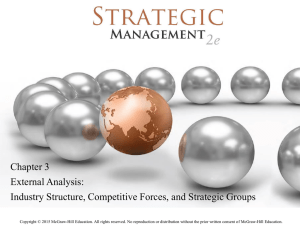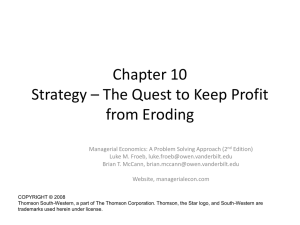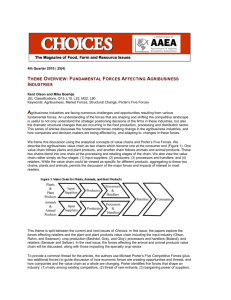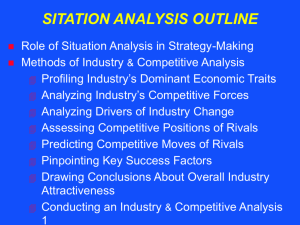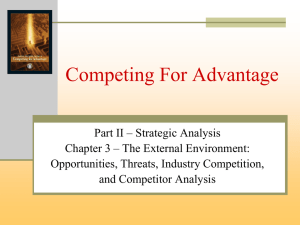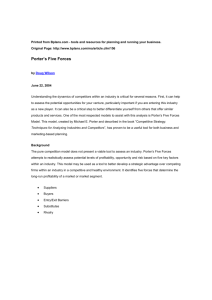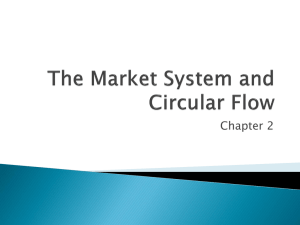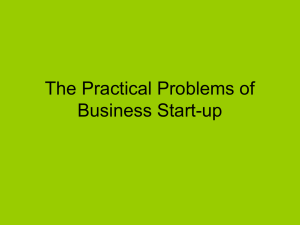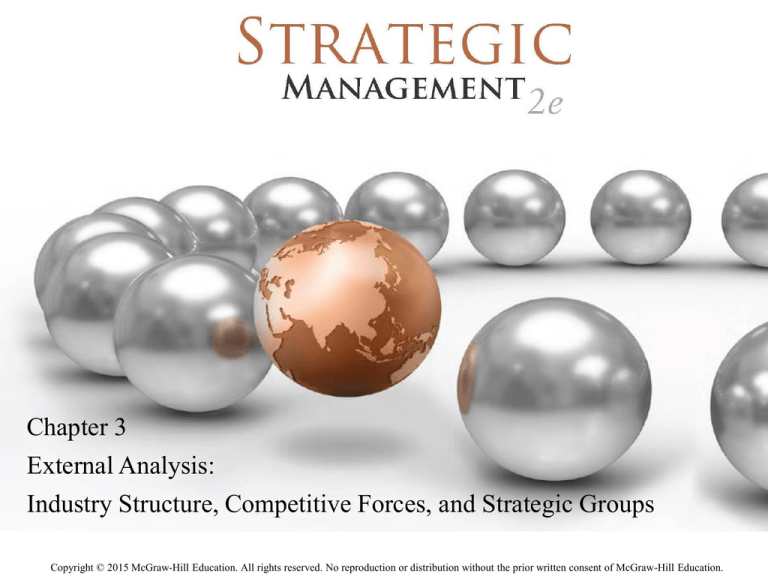
Chapter 3
External Analysis:
Industry Structure, Competitive Forces, and Strategic Groups
Copyright © 2015 McGraw-Hill Education. All rights reserved. No reproduction or distribution without the prior written consent of McGraw-Hill Education.
Exhibit 3.1 The Firm Embedded in
Its External Environment
3-2
Political/Legal Factors
Political environment
• Processes/actions of government that can influence the
decisions and behavior of firms
Legal environment
• Laws, mandates, regulations, and court decisions – all of
which can have a direct bearing on a firm’s profit potential
3-3
Economic Factors
Economy-wide phenomena, consisting of the following
five macroeconomic factors affecting firm strategy:
•
•
•
•
•
Growth rates
Interest rates
Levels of employment
Price stability (inflation and deflation)
Currency exchange rates
3-4
Strategy Highlight 3.1
How the Eurozone Crisis Is Hurting Companies
The EU (European Union) began its formation in the
early 1950s.
Today – The euro is the common currency used by 17
of the 27 EU member states.
2009 – Several European countries took on too much
debt and were unable to repay their credit obligations.
Strict austerity programs were enacted.
Banks tightened credit hampering firms worldwide.
3-5
ChapterCase 3
Courtesy of Tesla Motors
Tesla Motors and the U.S. Automotive Industry
With high entry barriers, the BIG THREE – GM, Ford,
and Chrysler – dominated the U.S. car market until the
1980s.
There have been no new recent entrants due to the
HIGH industry entry barriers.
Tesla Motors’ Model S received outstanding market
reception, and was awarded the 2013 MotorTrend Car
of the Year.
3-6
Sociocultural Factors
Sociocultural factors
• Capture cultures, norms, and values for society; are
dynamic and differ across groups.
• Implications for firm strategy must be considered.
Demographic trends
• Capture population characteristics related to age, gender,
family size, ethnicity, sexual orientation, religion, and
socioeconomic class.
3-7
Technological Factors
Technological factors
• Capture the application of knowledge to create new
processes and products.
Innovations in process technology
• Lean manufacturing, Six Sigma quality, and biotechnology.
Nanotechnology revolution
• (Initial stages) Major upheaval for several industries –
medical devices to new-age materials for earthquakeresistant buildings.
3-8
Ecological Factors
Broad environmental issues, e.g., the natural
environment, global warming, and sustainable
economic growth
Business and natural worlds are interdependent and
inextricably linked.
Managing these relationships in a sustainable manner
directly influences the continued existence of human
societies and the organizations we create.
3-9
Exhibit 3.2 Porter’s Five Forces Model
3-10
FIVE FORCES MODEL –
MICHAEL PORTER
A framework for identifying the five forces that
determine industry profit potential and help shape
firm competitive strategy
This model intersects:
• Theory: industrial organization economics with
• Practice: hundreds of case studies
Managers can predict industry profit potential and
position their firms for sustainable competitive
advantage.
3-11
3.2 Industry Structure and Firm
Strategy: The Five Forces Model
Industry
• A group of (incumbent) firms that face the same set of
suppliers and buyers
Industry Analysis
• Identifies the industry's profit potential
• Derive implications for a firm’s strategic position within an
industry
Strategic Position
• A firm’s ability to create value (V) for customers while
containing costs (C)
Competitive Advantage = a large value gap (V - C)
3-12
INDUSTRY FORCES IMPACT FIRM PROFITABILITY
ATTRACTIVE INDUSTRY
Sustainable Competitive Advantage Easier
• High profit potential
• The weaker the five forces
UNATTRACTIVE INDUSTRY
Sustainable Competitive Advantage Harder
• Low profit potential
• The stronger the five forces
3-13
3-14
Chapter Outline
3.1 The PESTEL Framework
3.2 Industry Structure and Firm Strategy: The Five Forces
Model
3.3 Changes over Time: Industry Dynamics
3.4 Explaining Performance Differences within the Same
Industry: Strategic Groups
3.5 Implications for the Strategist
3-15
EXTERNAL ANALYSIS
MACRO
• PESTEL Framework
INDUSTRY ANALYSIS
• Five Forces Model
MICRO
COMPETITOR ANALYSIS
• Strategic Group Mapping
3-16
EXTERNAL ANALYSIS
MACRO
• PESTEL Framework
INDUSTRY ANALYSIS
• Five Forces Model
MICRO
COMPETITOR ANALYSIS
• Strategic Group Mapping
3-17
Strategy Highlight 3.2
The Five Forces in the Airline Industry
Low Entry Barriers
Powerful Suppliers
Powerful Buyers
Strong Substitute Threat
Intense Rivalry
RESULTS – Low overall industry profit potential, thus
an “unattractive” industry for investment.
3-18
Exhibit 3.3
Industry Competitive Structures along
the Continuum from Fragmented to Consolidated
3-19
Adding a Sixth Force:
The Strategic Role of Complements
COMPLEMENT
• A product, service, or competency that adds value when
used in tandem with the original product offering
Complementor – A firm that provides a good/service
that leads customers to value your firm’s offering
more when the two are combined
Co-opetition – Cooperation by competitors to
achieve a strategic objective
3-20
3.3 Changes over Time:
Industry Dynamics
The static five forces model cannot determine the
speed of change for an industry.
As consolidated industries tend to be more profitable
than fragmented ones, firms tend to change their
industry structures toward being more consolidated
through (horizontal) mergers and acquisitions.
Industry Profitability
Consolidation
3-21
INDUSTRY CONVERGENCE
• A process whereby formerly unrelated industries begin to
satisfy the same customer need
Driver: Technological advances
Example: Convergence of media industries due to
technological progress in IT, telecommunications, and
digital media
3-22
EXTERNAL ANALYSIS
MACRO
• PESTEL Framework
INDUSTRY ANALYSIS
• Five Forces Model
MICRO
COMPETITOR ANALYSIS
• Strategic Group Mapping
3-23
STRATEGIC
GROUP
Set of firms
pursuing a similar
strategy within a
specific industry
STRATEGIC
GROUP MODEL
Framework that
explains performance
differences within the
FIRM
same industry by
PERFORMANCE
clustering different
firms into groups
Determined not only
based on key strategic
by the industry to
dimensions
which the firm
belongs, but also by its
strategic group
membership
3-24
3.4 Explaining Performance Differences
Within the Same Industry: Strategic Groups
Firms in the same strategic group follow a similar
strategy.
Strategic group differences identify business-level
strategies.
Direct competitors – same strategic group firms
Intra-group rivalry exceeds inter-group rivalry:
• Rivalry among firms within a strategic group is more intense
than the rivalry between strategic groups.
3-25
MAPPING STRATEGIC GROUPS
1. Identify important strategic dimensions.
2. For the horizontal and vertical axes – select two key
dimensions which expose pivotal differences among
the competitors.
•
These dimensions should not be highly correlated.
3. Graph the firms in their strategic groups, indicating each
firm’s market share by the size of the bubble with which
it is represented.
3-26
The Threat of Entry
Entry barriers
• The risk that potential competitors will enter an industry
With new entrants, profit potential is depressed for
incumbent firms:
• Lower prices
• Spend more to satisfy existing customers
3-27
The Threat of Entry
Incumbent firms can benefit from several important
sources of entry barriers:
•
•
•
•
•
•
•
Economies of scale
Network effects
Customer switching costs
Capital requirements
Advantages independent of size
Government policy
Credible threat of retaliation
3-28
The Power of Suppliers
POWERFUL SUPPLIERS
Can demand higher prices for their inputs.
Capture part (sometimes a large part) of the economic
value created.
-
Signs of Strong Suppliers
Suppliers industry is concentrated.
They don’t depend heavily on the incumbent’s industry.
Incumbent firms face high switching costs.
Suppliers’ products are differentiated.
Limited substitutes.
Suppliers have credible forward integration threats.
3-29
The Power of Buyers
The bargaining power of buyers impacts industry profit potential.
POWERFUL BUYERS
Can demand a lower price or higher product quality
Reduce industry profit potential:
• Through price discounts (limited revenue)
• Through increased quality / better service (higher costs)
• As they capture part of the economic value created
3-30
THE POWER OF BUYERS EXAMPLES
Google
• Faces strong buyer power from Samsung who has 40% of
Android-operated smartphones
Walmart
• As the world’s largest retailer, it leverages huge buyer
power from its suppliers.
CEMEX
• Strong buyer power in the U.S. leaves it very small profits
• Weaker buyer power in Mexico yields much higher profits.
3-31
The Threat of Substitutes
This threat derives from products/services fulfilling the
needs of current customers from outside the industry.
POWERFUL SUBSTITUTES: THE POWER OF
SUBSTITUTES is HIGH when:
• Price-performance: Has an attractive trade-off.
• The buyer’s switching cost is low.
Substitutes limit the price that industry competitors can
charge for their products/services.
3-32
Rivalry among Existing Competitors
The intensity of rivalry among existing competitors is
determined largely by the following factors:
COMPETITIVE INDUSTRY STRUCTURE
INDUSTRY GROWTH
STRATEGIC COMMITMENTS
EXIT BARRIERS
3-33
COMPETITIVE INDUSTRY STRUCTURE
The structure of an industry is captured by:
• Number and size of industry competitors
• Pricing power possessed by firms
• Products/services offered by firms
(Commodity vs. differentiated product)
• Height of entry barriers
3-34
Mobility Barriers
Mobility barriers
• Restricts movement between groups; industry-specific
factors that separate one strategic group from another
Exhibit 3.5 – Airline industry strategic groups:
• Hub-and-spoke group with international routes
• Point-to-point airline groups do not
3-35
Exhibit 3.5
Strategic Groups and the Mobility
Barrier in the U.S. Domestic Airline Industry
3-36
ChapterCase 3
Courtesy of Tesla Motors
Consider This…
• Recent dynamics in the automotive industry have lowered the
profit potential, reducing its attractiveness.
• Tesla Motors has demonstrated how new technology can be
used to circumvent entry barriers.
• However, incumbent firms are also introducing hybrid or allelectric cars, further increasing rivalry in the industry.
3-37
3-38


